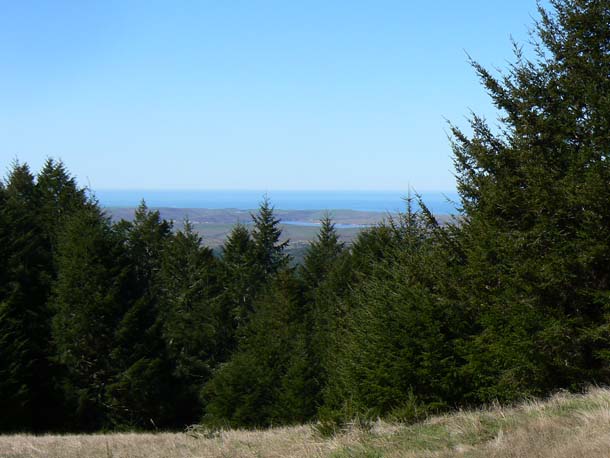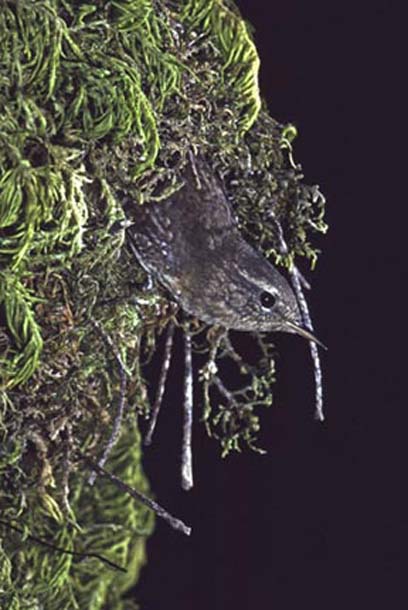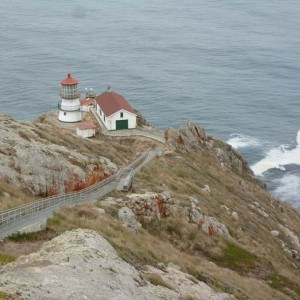Route: Morgan Trail to Horse Trail (0.6 mi), Horse Trail to Z-Ranch Trail (2.4 mi); Z Ranch Trail to Mount Wittenberg Trail (0.7 mi), summit spur (0.4 mi), Mt Wittenberg Trail to Bear Valley Trail (1.8 mi). Total = 5.9 mile loop.
Conditions: clear, calm, and warm (~60-65°F)
Check out these and other hikes Jules has taken on this Google map. The most recent hike is in blue; others are in red.
The Morgan Trail traces the forest edge before veering into dark fir and bay en route to the base of the Horse Trail. Once there, a footbridge across a seasonal creek leads upslope, through mixed evergreen forest toward the ridge. On this early spring walk, the birdsong that echoes through the forest on the eastern slope of Inverness Ridge is offered by resident species, birds that remain here year-round. These resident landbirds tend to nest earlier than the migrants who are here for only a portion of the year. Today, three species are particularly vocal along the Horse Trail–brown creeper, golden-crowned kinglet, and Pacific wren–each initiating its nesting cycle. Creeper and kinglet vocalizations were discussed in last week’s posting. While those species have subtle, whispering songs, the wren’s remarkable anthem that now echoes through the forest is another ball of wax, entirely.
-
Pacific wren emerging from nest. Formerly known as the winter wren (Troglodytes troglodytes) until field studies and recent genetic analysis determined that there are actually three species cryptically hidden in the populations. Photograph by Ian Tait.
The mild temperatures and increasing day length have ignited the wren chorale, a symphony that accompanies me along every step of this morning hike. The Pacific wren’s (Troglodytes pacificus) vocal repertoire is “near the pinnacle of song complexity” of North American birds and the most emphatic and exalted declaration of springtime on the peninsula. “Troglodytes” is the perfect name for this pygmy of the understory shadows. On any of the shady trails on Point Reyes–especially those that pass through damp fir forest–the music of the Pacific wren is perhaps the most common birdsong heard from March through May. It is also the most complex and beautiful, at least until the Swainson’s thrush chimes in during early summer. In his Birds of California (1924), Victorian birdman Leon Dawson describes the wren’s song as having a quality of “joyous abandon,” which “strikes the bird-lover as being one of the most refreshing in the West.” That such a tiny creature can produce such a voluminous and clarion song is truly awe-inspiring.
Listen to the song explained and recorded here.
Although the forest is shaded under the canopy of mixed evergreens–fir, bay, and live-oak–there are frequent sun-patches where trees have fallen, especially tan oaks that have succumbed to sudden oak death. Each of these little ponds of light is visited by flittering white butterflies.
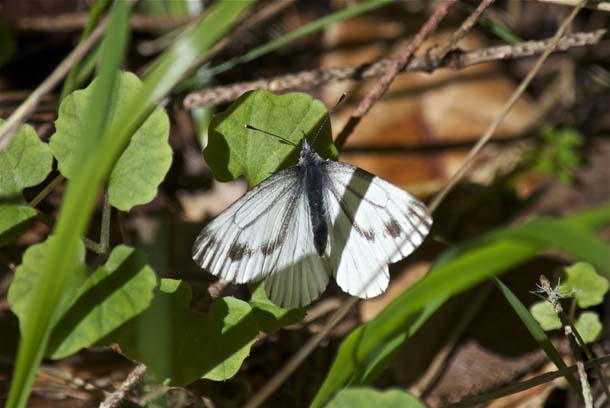
-
The “gray-veined white” butterfly is highly variable in the amount of patterning on the upper wing. This individual has more markings than most, which likely identifies it as an early spring female. (Compare to the apparent male posted on the Rift Zone Trail walk.) Photo by Jules Evens.
In an earlier post I identified these elfin sprites as margined whites (Pieris marginalis). Apparently, the taxonomy of this genus is under revision, and according to the excellent Field Guide Butterflies of the San Francisco Bay and Sacramento Valley Regions by Art Shapiro and Tim Manolis (2007, U.C. Press California Natural History Guide #92) until species relationships are better understood, this variable group is best called the “gray-veined whites” (Pieris “napi” complex). Whatever we call them, the flight this spring has been impressive, and I noticed more on this hike than I have to date.
Milkmaid (Cardamine californica, formerly Dentaria) is a primary nectar plant of this butterfly and the most common flower along the Horse Trail and other forested trails in early spring. I stop to try photographing some milkmaids and ferns in the dappled light, and hear the syncopated, monotone whistle of what sounds like a distant northern pygmy owl. This robin-sized owl is very rare in the coastal fog zone, so I listen intently and mimic the call, hoping to lure the gnome in close enough to see. After several minutes, and no success, I begin to suspect that I’m being snookered by a Steller’s jay. These ubiquitous “policemen of the forest” (Leon Dawson, again) often mimic the calls of other birds, particularly raptors, and I’ve been fooled before. Usually the jays mimic soaring birds of prey–red-tailed or red-shouldered hawks–but I’ve heard them make passable imitations of gray squirrels, northern flickers, ravens, dogs, and mechanical sounds such as creaking gates, back-up beepers, ring tones, even horse farts!
There is ample deadfall in the forest, either diseased, wind-trimmed, or felled in the course of trail maintenance. Perhaps this decadence accounts for the six species of woodpeckers working the wood this morning (acorn, downy, hairy, Nuttall’s, pileated, and northern flicker).
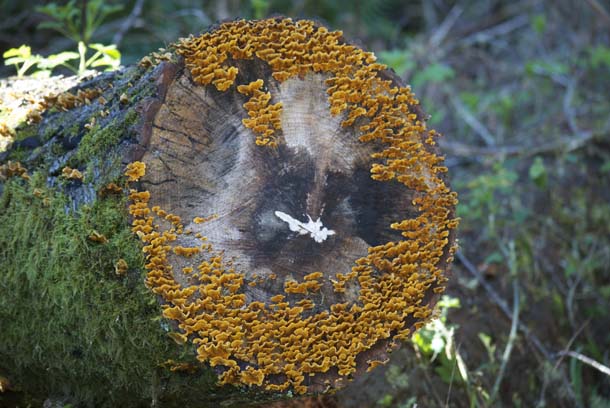
-
This felled Douglas-fir, in a relaxed state of decomposition along the Horse Trail, is adorned with an attractive colony “crowded parchment” (Stereum complicatum?) fungi on its bark and sapwood.
Saprophytes, like the fungi shown here, serve a valuable function in forest ecology, working as decomposers in concert with bacteria, insects, snails and slugs, to recycle crucial nutrients–carbon, nitrogen, minerals– from dead organic matter and then returning it to the soil to be reabsorbed by plants. Even when alive, the Douglas-fir relies on symbiotic root fungi (mycorrhizae) to supply nutrients from the soil.
The wind sows the seed, the sun evaporates the sea, the wind blows the vapor to the field . . . the rain feeds the plant and the plant feeds the animal. –Henry David Thoreau, in the essay “Walking.”
As I approach the junction with the Z Ranch Trail, a smallish bobcat emerges silently from the understory and pauses to check me out. I’ve seen three of these appealing predators on the last six hikes, one every 10 or so miles walked. Perhaps it’s a good bobcat year, or, more likely, walking quietly and alone increases one’s chances of an encounter.

-
This bobcat assesses me in the middle of the Horse Trail near the summit. Photo by Jules Evens.
Where the Z Ranch Trail meets the Mount Wittenberg Trail, a large meadow offers a convenient lunch stop, and decent views of Drake’s Estero and the outer point, although the firs have colonized some of this grassland over the last several decades, partially obscuring the once sweeping view.
There is a short spur that leads to the actual summit of Mount Wittenberg (1407 feet), the pinnacle of Inverness Ridge, the highest elevation in the park. Apparently the Wittenbergs were North Carolinians, a father and son who leased the hilly land in 1860 for a dairy ranch. The survey marker proves rather hard to find, and oddly, it rests about three feet in elevation below the actual highest point on the ridge.

-
U.S. Coast & Geodetic Survey marker placed near the summit of Mount Wittenberg in 1930. Not that easy to find because it’s not actually at the peak. Photo by Jules Evens.
This bulge in the spine of Point Reyes looks something like the humped back of a granitic whale migrating northward about as fast as my hair grows. The peninsula’s backbone, Inverness Ridge, is the eastern edge of the Salinian Block, or the Salinean Terrane, a large granitic basement that lies west of the San Andreas. The granitodiorite bedrock is very similar to that found on Bodega Head, the Cordell Bank, the Farallon Islands, Montara Mountain (San Mateo County), Ben Lomond (Santa Cruz County) and the Santa Lucia Mountains (Monterey and San Luis Obispo counties) indicating that each site is an exposed portion of this massive block. Furthermore, the composition of basement rock is nearly identical to that of the Sierra Nevada and is thought to have formed as a southern extension of the Sierra, then ripped asunder by the San Andreas fault, and has been traveling northward ever since . . . “one earthquake at a time,” as Nina Fitzgerald says on her blog watchingforrocks.
The Mount Wittenberg Trail that leads back down to Bear Valley is steep and deeply incised by water runoff in places. As I descended in early afternoon, I encountered several horseback riders and gaggles of hikers making the arduous climb. It’s a butt burner, and I had to congratulate myself for taking the easier route of the loop–up Horse Trail and then down the Wittenberg Trail.

-
Sandcrocus (Romulea rosea var. australis). This attractive little iris, blooming in sandy, disturbed soil along the Bear Valley trail near the Mount Wittenberg trailhead, is not native here. It was first found on the peninsula in 1979. It is short-stemmed and has tough grass-like leaves and “probably came to California by way of Australia . . . in seed of subterranean cover” (Marin Flora). Photo by Jules Evens.
At the bottom, at the junction with the Bear Valley trail, I noticed a scattering of attractive small flowers that I’d didn’t recognize. Seeing this unfamiliar flower fed my slowly dawning realization–gained after completing about one quarter of my “trail challenge”– that although I’ve walked the Point Reyes trails for nearly four decades, something new always appears, more to learn, something to puzzle over, again. Later, National Park Service biologist Amelia Ryan and Lorraine Parsons, both beautiful black-belt botanists, help me identify this as an exotic introduction from Australia, Romulea.
CRITTER LIST
INVERTEBRATES
Banana Slug (Ariolimax spp.)
Margined White Butterfly (Pieris marginalis venosa? )
Satyr Anglewing Butterfly (Polygonia satyrus)
Red Admiral Vanessa (Atalanta rubria)
Yellow-headed bumblebee (Bombus caliginosus)
BIRDS The usual suspects, except Pacific-slope Flycatcher: first of season (FOS)
Acorn Woodpecker
Allen’s Hummingbird
American Goldfinch
American Robin
Anna’s Hummingbird
Band-tailed Pigeon
Black Phoebe
Brewer’s Blackbird
Brown Creeper
Bushtit
California Quail
California Towhee
Chestnut-backed Chickadee
Common Raven
Dark-eyed Junco
Downy Woodpecker
European Starling
Fox Sparrow
Golden-crowned Kinglet
Golden-crowned Sparrow
Hairy Woodpecker
Hermit Thrush
Hutton’s Vireo
Northern Flicker
Nuttall’s Woodpecker
Osprey
Pacific-slope Flycatcher (FOS)
Pileated Woodpecker
Pine Siskin
Purple Finch
Pygmy Nuthatch
Red-breasted Nuthatch
Red-shouldered Hawk
Red-tailed Hawk
Red-winged Blackbird
Ruby-crowned Kinglet
Song Sparrow
Spotted Towhee
Steller’s Jay
Townsend’s Warbler
Turkey Vulture
Varied Thrush
Violet-green Swallow
Western Bluebird
Western Scrub-Jay
White-crowned Sparrow
White-tailed Kite
Winter Wren
Wrentit
Yellow-rumped Warbler
MAMMALS
Bobcat
Morgan horse (6)
Human being (~16)
Thomys Pocket Gopher (burrows)
Western Gray Squirrel
Acknowledgement: Thanks to Michele Blackman for insect identification.

